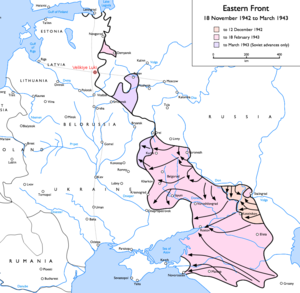Battle for Velikiye Luki
| Battle of Velikiye Luki | |||||||
|---|---|---|---|---|---|---|---|
| Part of the Eastern Front of World War II | |||||||
 Velikiye Luki (red, upper left) and the nearby rail trunks, in the context of the Soviet 1942–1943 offensives. (click to enlarge) |
|||||||
|
|||||||
| Belligerents | |||||||
|
|
|
||||||
| Commanders and leaders | |||||||
|
|
|
||||||
| Strength | |||||||
|
LIX Korps – ~50,000 (on 19 Nov) Reinforcement forces: ~50,000 |
3rd Shock Army – 95,608 (on 19 Nov) Reinforcement forces: 86,700 |
||||||
| Casualties and losses | |||||||
| Soviet estimate: ~60.000 killed, missing or wounded, 4.500 captured |
104,022 31,674 killed or missing 72,348 wounded |
||||||
The Velikiye Luki offensive operation (Russian: Великолукская наступательная операция) was executed by the forces of the Red Army's Kalinin Front against the Wehrmacht's 3rd Panzer Army during the Winter Campaign of 1942–1943 with the objective of liberating the Russian city of Velikiye Luki as part of the northern pincer of the Rzhev-Sychevka Strategic Offensive Operation (Operation Mars).
As part of Operation Barbarossa, the German LVII Panzer Corps took Velikiye Luki on 19 July 1941, but was forced to retreat the next day due to Soviet counter-attacks breaking the line of communications in multiple places. A new attack was launched in late August by both the LVII and XXXX Panzer Corps, and the city was recaptured on Aug. 26.
The city had great strategic value due to the main north-south railway line running just west of the city at Novosokolniki, as well as the city's own rail network to Vitebsk and bridges over the Lovat River. After its capture and with the German offensive running out of steam for the winter, the area was fortified. Marshy terrain extended to Lake Peipus from just north of the city defended by the German 16th Field Army, making operations in the region around the city difficult for both sides. Rather than maintaining a solid "front" in the area, the Germans established a series of thinly held outposts to the north and south of the city.
Soviet counterattacks during the Winter Campaign of 1941–1942, especially the Battles of Rzhev just to the south, formed a large salient in the German lines. Velikiye Luki lay just on the western edge of the original advance, and was just as strategic for the Soviets as the German. The city dominated the region and would therefore be the natural point for fighting, offering the possibility of eliminating the German bridges on the Lovat, and to deny the Germans use of the rail line that provided communications between Army groups North and Centre. Furthermore, as long as the German Army occupied both rail junctions at Velikiye Luki and Rzhev, the Red Army could not reliably reinforce or resupply its troops on the north face of the massive Rzhev Salient.
...
Wikipedia
